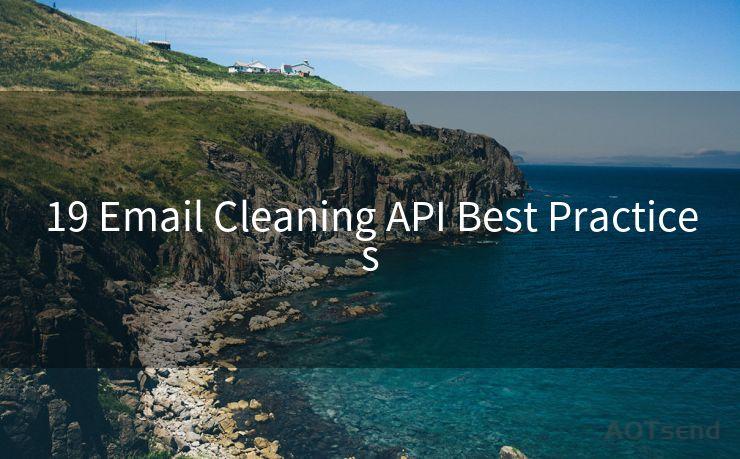19 Email Cleaning API Best Practices




In the world of digital marketing and customer communication, maintaining a clean and up-to-date email list is crucial. An Email Cleaning API can be a powerful tool to help you achieve this goal. In this article, we'll explore 19 best practices for using an Email Cleaning API to ensure optimal performance and enhance your email marketing efforts.
1. Understand the API's Capabilities
Before integrating an Email Cleaning API into your system, it's essential to understand its full capabilities. Read the documentation thoroughly and familiarize yourself with the features, limitations, and requirements of the API.
2. Set Clear Goals
Define your objectives for using the Email Cleaning API. Are you aiming to remove invalid emails, detect disposable addresses, or identify spam traps? Having clear goals will help you make the most of the API's features.
3. Integrate Smoothly
Ensure a seamless integration of the API into your existing system. Follow the provided integration guides and best practices to avoid any technical glitches.

4. Validate Emails in Real-Time
Utilize the API to validate emails in real-time during user registration or data entry. This immediate validation can significantly reduce the number of invalid emails entering your database.
5. Regularly Clean Your List
Perform periodic cleaning of your email list using the API. This helps to remove bounced, invalid, or inactive emails, keeping your list fresh and engaged.
6. Monitor API Usage
Keep track of your API usage to ensure you're not exceeding any limits or quotas. Most Email Cleaning APIs have usage restrictions, so it's important to monitor and adjust your usage accordingly.
7. Handle Errors Gracefully
Implement robust error handling mechanisms to manage API failures or timeouts gracefully. This ensures that your application can recover from any temporary issues with the API.
8. Protect User Privacy
When handling email data, always prioritize user privacy. Ensure that your use of the Email Cleaning API complies with privacy regulations and best practices.
9. Test, Test, and Test Again
Conduct thorough testing of the API integration before going live. This includes testing various scenarios, such as valid and invalid emails, to ensure the API responds as expected.
10. Optimize for Performance
Fine-tune your API requests to minimize latency and maximize throughput. This might involve caching results, batch processing, or adjusting request frequencies.
11. Stay Updated
Keep yourself informed about any updates or changes to the Email Cleaning API. Subscribe to the provider's newsletters, follow their social media channels, or check their official documentation regularly.
12. Use Advanced Features
Explore and utilize advanced features like email formatting validation, MX record checks, or typo correction suggestions to enhance the quality of your email list even further.
13. Balance Cost and Effectiveness
Consider the cost-effectiveness of the Email Cleaning API. While it's essential to maintain a clean email list, ensure that the investment in the API aligns with your business goals and budget.
14. Measure Results
Track and measure the impact of using the Email Cleaning API on your email marketing campaigns. Monitor key metrics like open rates, click-through rates, and conversions to assess the effectiveness of your cleaned list.
🔔🔔🔔
【AOTsend Email API】:AOTsend is a Managed Email Service for sending transactional emails. Support Email Types: reminders, authentication, confirmations, notifications, verification codes, invoices, password resets, account activations, billing statements, two-factor authentication (2FA), and one-time passwords (OTP) emails, etc. $0.28 per 1000 Emails. 99% Delivery, 98% Inbox Rate.
You might be interested in:
Why did we start the AOTsend project, Brand Story?
What is a Managed Email API, How it Works?
Best 25+ Email Marketing Platforms (Authority,Keywords&Traffic Comparison)
Best 24+ Email Marketing Service (Price, Pros&Cons Comparison)
Email APIs vs SMTP: How they Works, Any Difference?
15. Provide Feedback
If you encounter any issues or have suggestions for improving the Email Cleaning API, don't hesitate to provide feedback to the provider. Your input can help shape the future development of the API.
16. Educate Your Team
Ensure that your team is well-versed in using the Email Cleaning API. Provide training and documentation to empower them to make the most of this tool.
17. Backup Your Data
Regularly backup your email list before performing any cleaning operations. This precautionary measure ensures that you can restore any accidentally deleted or modified data.
18. Leverage Automation
Automate the email cleaning process as much as possible. Set up scheduled tasks or triggers to automatically validate and clean your email list at regular intervals.
19. Continuously Improve
Continuously evaluate and improve your email cleaning strategies based on the insights gained from using the API. Stay agile and adapt to changing best practices and industry trends.
By following these 19 best practices, you can maximize the effectiveness of your Email Cleaning API integration and enhance the performance of your email marketing campaigns. Remember, a clean and engaged email list is key to achieving successful outcomes in the competitive world of digital marketing.




Scan the QR code to access on your mobile device.
Copyright notice: This article is published by AotSend. Reproduction requires attribution.
Article Link:https://www.mailwot.com/p2707.html



